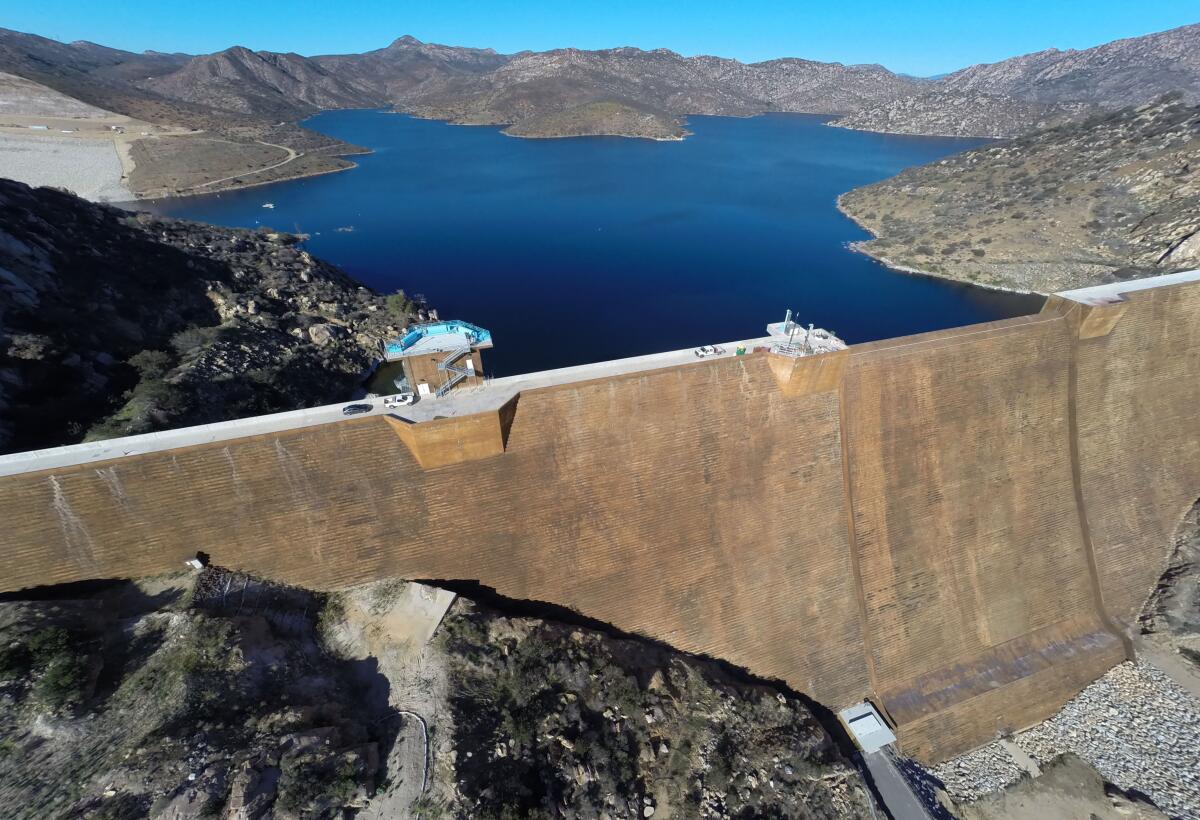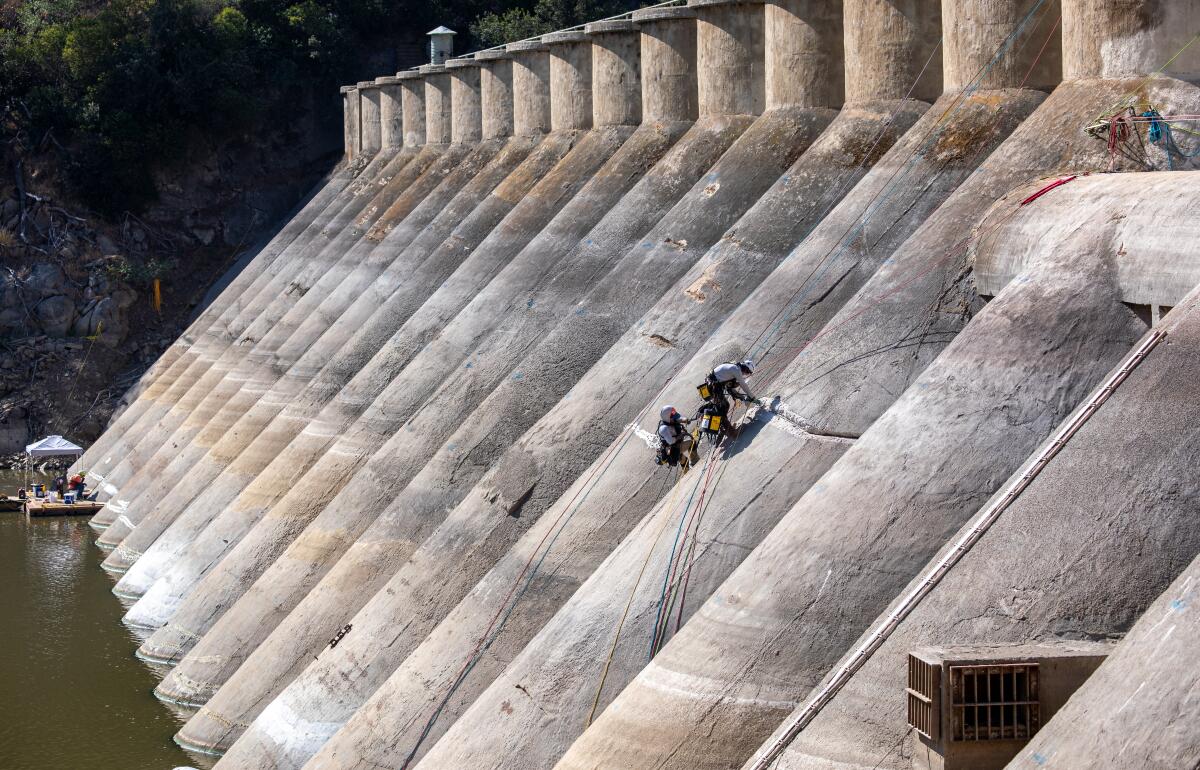Despite ‘multitude of risks,’ San Diego region could tap cash reserves to blunt spiking water rates

- Share via
SAN DIEGO — San Diego leaders have directed the region’s water wholesaler to pinch every penny this year in the agency’s $1.8-billion budget, as ratepayers continue to grapple with ever-higher utility bills.
The San Diego County Water Authority has in response made substantial changes to its spending plan, looking to cut several positions and delay about $48 million in capital projects, including a pumped hydropower facility at San Vicente Dam.
This story is for subscribers
We offer subscribers exclusive access to our best journalism.
Thank you for your support.
However, top officials with the region’s wholesaler, which imports water from the Colorado River and Sacramento Delta, warned this week that digging too deep into agency reserves could compromise its long-term financial health.
“There’s a multitude of risks,” Lisa Marie Harris, the water authority’s chief financial officer, told board members Thursday. “Managing a $2-billion debt portfolio is very complex and very challenging.”
Members of the water authority’s finance committee voted regardless to aggressively draw down the agency’s rate stabilization fund over the next two years. The fund, which is typically used to offset large rate increases, currently stands at about $101 million. The full 36-member governing board could debate the issue again in June when it finalizes the agency’s two-year budget.
The water authority had earlier this year envisioned a whopping 14% spike in the cost of wholesale supplies. The situation is largely the result of plummeting sales from drought conservation and skyrocketing costs at the desalination plant in Carlsbad.
With recent adjustments, the agency now expects to keep cost increases to about 8% annually through 2025 for most of the region’s roughly two dozen retail agencies, from East County’s sprawling Otay Water District to Carlsbad and Escondido.
“We’ve been very clear from the city of San Diego’s perspective that we would not accept a double-digit rate increase under any circumstance,” said Nick Serrano, one of the city’s 10 representatives on the agency’s board and Mayor Todd Gloria’s deputy chief of staff.
That may help ease sticker shock in the short term as costly sewage recycling projects come online across the region. The city of San Diego, for example, plans to raise rates a whopping 10% and nearly 9% over the next two years largely as a result of wholesale increases coupled with its Pure Water project.

But depleting the water authority’s fast-dwindling reserves could also set the agency up for a credit downgrade. The agency’s rate stabilization fund is part of an overall reserve balance that has been cut in half since reaching a high-water mark of about $400 million in 2014.
“There are big trade-offs between rate increases now, versus rate increases later,” Pierce Rossum, the agency’s rate and debt manager, told board members Thursday.
“We will fall to a low balance of under $200 million in April of next year,” he added. “That is an incredibly low cash position.”
Some board members had appeared to take that message to heart, such as Carlsbad board member Keith Lewinger, who will step down this month after serving more than two decades on the wholesaler’s oversight panel.
“We don’t want to give the rating agencies or the IRS or anybody else a reason to scrutinize whether or not we’re meeting our bond coverage,” he said at a meeting last week.
Still, Lewinger made the motion on Thursday to dig deeply into reserves — pushing back on efforts by the city of San Diego to cut even further.
The wholesaler’s draft budget paints a grim picture, opening with a startling message from the agency’s soon-to-retire general manager, Sandy Kerl.
“Put simply,” she writes to her board, “this is the most challenging budget cycle I’ve seen in more than three decades of public service leadership. The headwinds were strong from the start and they only got stronger over the past three months, with unexpectedly large energy bills driving up costs and the persistence of highly unusual wet weather that has depressed water sales.”
Perhaps most notably, the energy-hungry desalination plant in Carlsbad recently saw its bills from San Diego Gas & Electric jump 47%, creating a $17-million shortfall.
Meanwhile, California’s wet weather, while welcome, has reduced outdoor irrigation, leading to less sales revenue for the water authority. The agency has seen its member agencies purchase less and less water over the last two decades, as a result of turf rebate programs, struggling agriculture and general drought conservation.
The situation could get significantly worse as local recycling projects from Oceanside to San Diego to El Cajon come online in the next few years. The water authority said it expects to sell roughly 360,000 acre-feet next year, down from a peak of 660,000 acre-feet in 2007.
Recycling efforts could further reduce demand for wholesale water by more than 55,000 acre-feet before the end of the decade, according to agency projections. (An acre-foot is enough water to cover an acre a foot deep, or 325,851 gallons.)
In addition, the water authority also expects to see its costs increase by $25 million to $30 million annually through 2028 as a result of rate increases from the Metropolitan Water District of Southern California. The Los Angeles-based agency, which not only sells wholesale supplies to San Diego but transports the region’s Colorado River water, largely blamed inflation and soaring power costs.
The San Diego wholesaler is also bracing for a loss of $2.8 million annually over the next decade as a result of ongoing repairs to Lake Hodges Dam. The agency would usually be able to generate hydroelectricity at the century-old facility, but the construction requires that reservoir levels remain too low to operate the system.

More to Read
Sign up for Essential California
The most important California stories and recommendations in your inbox every morning.
You may occasionally receive promotional content from the Los Angeles Times.














